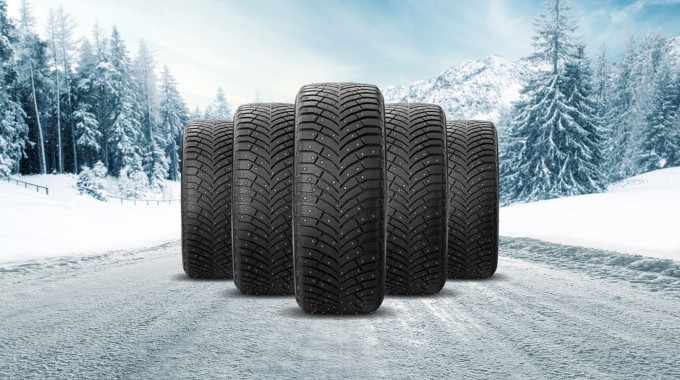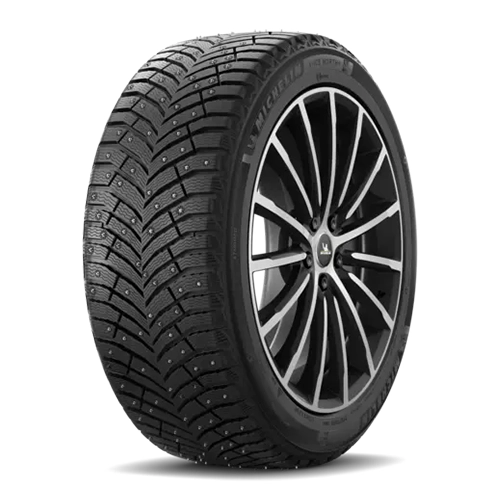
Oct 10, 2025
Michelin X-Ice North 4 Tire Review
The Michelin X-Ice North 4 (often styled X-Ice North 4 or X Ice North 4) is one of Michelin’s flagship “severe winter” tires designed for Canada’s harsh winter conditions. It is targeted at drivers who demand maximum ice traction, good snow capability, and confidence in freezing rain and glare ice situations.
In many markets, it is offered as a studded or studdable winter tire, combining a directional tread design, interlocking 3D sipes, and strategic stud placement to deliver exceptional control under extreme winter conditions.
Testers and user reviews consistently praise its ice performance, snow traction, and overall winter performance, though its wet braking and rolling resistance are commonly cited as relative weak points.
In Canada, the Michelin X-Ice North 4 is positioned as a top-tier winter tire for passenger cars and crossovers, recommended for harsh winter conditions, deep snow, freezing rain, and general winter performance.
Below, we break down key technical aspects and comparative performance topics.

Tread Depth of Michelin X-Ice North 4
Michelin does not publicly specify a single universal tread depth for all sizes of the X-Ice North 4, but driver reports and independent reviews provide useful clues. In one “living with winter” review after ~8,000 km, the writer noted that “the tread depth remains strong, and the studs show little wear.” Motor Illustrated
More telling are independent tyre test summaries: AllTyreTests reports that the X-Ice North 4 “excels in ice performance, ranking 2nd for braking, handling, and traction and in the top 3 for all snow aspects. … it also performs well on dry roads …” which implies the tread design (depth + block geometry) remains competitive over its useful life. AllTyreTests.com
Because the tire is marketed for “severe winter conditions,” the initial tread depth is likely optimized for long-term bite: deeper than a mild winter tire, but still engineered to maintain performance as wear occurs. That said, exact metrics (for example, in mm) per size are not routinely published by Michelin in publicly accessible Canadian spec sheets.
In practice, one should monitor remaining tread depth and stud retention closely, especially when the depth approaches 4 mm or lower, where ice and snow bite begin to degrade significantly.
Tire Pressure for Michelin X-Ice North 4
Michelin does not publish a blanket “ideal pressure” that applies across all vehicles and sizes of X-Ice North 4. Instead, the vehicle manufacturer’s recommended tire pressure (found in the owner’s manual or on the driver’s door jamb placard) should be used. This ensures safe load carrying, optimizes wear, and helps maintain fuel economy/rolling resistance.
That said, when installing winter tires (including X-Ice North 4), a few practical recommendations and caveats arise:
-
Use the same recommended pressure (cold inflation) as for your all-season / summer tires, unless advised otherwise by the vehicle maker.
-
In very cold temperatures, pressure can drop slightly (~1–2 psi), so it's wise to check before driving in freezing conditions.
-
Avoid overinflation: too-high pressure reduces the contact patch, potentially degrading snow traction, ice traction, and comfort.
-
Avoid underinflation: too-low pressure impairs dry braking, wet handling, and increases wear, especially in a demanding winter tire.
Because rolling resistance and fuel consumption are considerations, overinflating to reduce rolling resistance may deliver diminishing returns or harm grip in ice or snow. Always stay within the sidewall maximum and manufacture guidelines.
In summary: for Michelin X-Ice North 4 tire pressure, follow your vehicle maker’s cold-pressure specification, check regularly in winter, and avoid excessive over- or under-inflation.
Sizes of Michelin X-Ice North 4 Tire
Michelin offers the X-Ice North 4 in a fairly broad range of sizes (especially for passenger and CUV / small SUV use). There are 50 sizes available to fit various SUV / crossover and passenger car applications.
Because winter tires must match the vehicle’s specified sizes and load/speed ratings, not all sizes will be available in your region or for all vehicles. Always confirm fitment compatibility with your tires/wheel shop.
Keep in mind that studded versions may be restricted in certain provinces; in many jurisdictions, studded tires are prohibited or only allowed seasonally. The X-Ice North 4 is marketed as studdable or studded in Canada.
It’s worth noting that the tire may also be suited for larger crossovers or light SUVs in some markets (e.g. X-Ice North 4 SUV studded variants).
Warranty for Michelin X-Ice North 4 Tire (and Michelin Promise Plan)
Michelin supports the X-Ice North 4 with a robust warranty package under the Michelin Promise Plan. According to Discount Tire:
-
60-day satisfaction guarantee (you can return if not satisfied)
-
Roadside assistance (for the life of the tire’s original usable tread)
-
Standard Limited Warranty against defects in workmanship and materials for the life of the tire’s original usable tread, or 6 years from date of purchase (whichever comes first).
That gives users protection against manufacturing defects, but does not guarantee against wear or damage from road hazards, misuse, etc.
Because studded winter tires inherently face more mechanical stress (stud wear, stone pitting, etc.), it is crucial to confirm that stud retention and other mechanical wear phenomena are covered under the “workmanship/material” portion of the warranty in your region. Michelin’s general policies typically exclude routine wear, so warranty claims for worn studs or low tread depth will be unlikely unless a clear defect is demonstrated.
Also, confirm with your Canadian retailer or Michelin Canada whether the full warranty applies to studded models in your province, as local regulations or seasonal restrictions might impose limitations.
In short: the Michelin Promise Plan gives you a 60-day satisfaction guarantee, roadside assistance, and limited warranty on defects (up to 6 years or usable original tread). But physical wear, stud loss, or misuse are not generally covered.
How Long Do Michelin X-Ice North 4 Tires Last?
Estimating the lifespan of a severe-duty winter tire like the X-Ice North 4 depends heavily on driving habits, winter conditions, road salt, stud loss, maintenance, and seasonal use. That said, both lab tests and user reports provide useful benchmarks.
Real-World User Reports
-
In the TyreReviews user reviews, one driver from Manitoba claimed running the North 4 studded for 3 winters (20,000–25,000 km) with “never let me down.” Tire Reviews
-
Another user, driving in harsh Canadian winters, noted that noise was negligible and grip in deep snow and freezing rain was excellent. Michelin Canada
-
The “living with winter” review after 8,000 km observed little stud wear and remained tread depth. Motor Illustrated
Test and Lab Data
Independent test summaries indicate the X-Ice North 4 ranks among the top for ice braking, handling, traction, and also scores well for noise suppression. These suggest the tread compound and block design retain performance well over life.
However, those same tests often flag its wet braking and rolling resistance as weaker than top non-studded winter tires. Over time, as tread wears, the relative gap in wet braking may widen. AllTyreTests
Estimated Lifespan
If used only in winter months (i.e. removed in spring/summer), properly inflated and rotated, a well-cared-for X-Ice North 4 might last 4 to 6 winter seasons under moderate use (say 15,000–25,000 km per winter). In harsher usage or higher mileage, wear, stud loss, or performance degradation may shorten practical life to 2–4 winters.
By the time the tread depth falls below ~4 mm (or when stud retention becomes compromised), traction in snow and especially ice may suffer. At that point many users choose to retire or relegate the tires to less critical service.
In summary: Michelin X-Ice North 4 tires are capable of long life under proper care, but realistic expectations are 3–6 winters depending on usage and conditions.
Michelin X-Ice vs X-Ice Snow (X Ice Snow)
What is Michelin X-Ice Snow?
“X-Ice Snow” (sometimes styled X Ice Snow or X-Ice SNOW) is Michelin’s more recent or upcoming studless winter tire line, intended to replace older designs like X-Ice Xi3 (in passenger) and Latitude X-Ice Xi2 (in SUV forms). Michelin
The X-Ice Snow design is built with full-depth 3D sipes, dual-format biting edges, and a compound engineered for long-lasting snow and ice performance. Michelin claims shorter ice braking distances (in certain lab tests) compared to competitors, and improved hydroplaning/slush resistance.
In North America, the X-Ice Snow is positioned as the successor to older Xi-series studless snow tires.
Comparison: X-Ice North 4 vs X-Ice Snow
-
Studded vs Studless: The X-Ice North 4 is a studded/studdable winter tire, optimized for maximum ice traction even on glare ice. By contrast, X-Ice Snow is studless, relying solely on 3D sipes and compound for grip. Thus, North 4 tends to outperform on pure ice, especially in freezing rain or glare ice, where mechanical bite from studs gives an edge.
-
Wet Braking & Handling: The X-Ice North 4 is frequently criticized in tests for weaker wet braking. Meanwhile, because X-Ice Snow is studless and more optimized for hydroplaning and slush resistance, it may hold an advantage in wet handling in non-icy conditions.
-
Rolling Resistance / Fuel Economy: Studless tires typically have lower rolling resistance than studded equivalents, so X-Ice Snow may offer better fuel consumption or lower rolling drag in mixed conditions. The North 4’s studding and aggressive geometry can worsen rolling resistance.
-
Noise Levels: Studded tires normally generate more noise due to metal studs. Michelin claims their stud arrangement and tuning minimize noise for the North 4. However, the studless X-Ice Snow likely will enjoy quieter operation on bare pavement.
-
Snow & Slush Performance: In deep snow and slush, both perform well, but the studless X-Ice Snow may have an advantage in fluid evacuation and consistency of grip across conditions. The North 4 will still perform well in snow due to its directional tread and interlocking 3D sipes.
-
Durability & Wear: Studless tires often show fewer mechanical wear concerns (no stud loss) and more consistent wear. Studded tires like the North 4 risk stud loss, rim damage, and stud hole wear over time.
In head-to-head tyre-review comparisons (e.g. “X-Ice North 4 vs X-Ice Snow”), the North 4 often shows better ice traction and overall winter grip, while the Snow variant may retain advantages in wet braking and possibly rolling efficiency.
If your conditions often include clean ice, freezing rain, or glare ice (e.g. Northern Canada, rural areas), the X-Ice North 4 may be the safer bet. If your driving includes more slushy roads, wet segments, or city driving where snow is cleared, X-Ice Snow becomes more attractive. For many, the choice is balancing maximum grip (with studs) versus fuel economy / ride comfort (without studs).
Michelin X-Ice North 4 vs Other Studded Options
Advantage Over Generic Studded Tires
-
Stud Design & Placement: The North 4 uses an innovative stud design and placement algorithm intended to reduce noise and optimize grip in braking, cornering, and accelerating.
-
Directional Tread + Interlocking Sipes: Combined with directional tread and interlocking 3D sipes, the North 4 aims to maximize the synergy between stud bite and tread biting edges. Many generic studded tires may rely more heavily on studs and less on advanced block / siping geometry.
-
Refinement & Noise Tuning: Michelin markets the North 4 as providing a “quiet, comfortable ride” despite being studded, thanks to stud placement and a “quiet tread compound”.
-
Warranty / Support: Some lower-cost studded tire makers may not offer warranties comparable to Michelin (Promise Plan, limited warranty, roadside assistance). The brand recognition and support network can be an asset in cold climates.
Weaknesses / Tradeoffs vs Alternative Studded Tires
-
In independent tyre tests, while North 4 often ranks in the top tier, it is sometimes outperformed by specialized studded options in wet braking and rolling resistance.
-
Studded tire performance tends to degrade as studs wear or drop; some specialized studded models may use harder or more durable stud materials or mounting that resist loss longer.
-
On bare pavement or during transitions (ice/slush to wet road), aggressive studded tires can harshly penalize dry braking, wet handling, and ride smoothness; some alternative studded designs may strike different trade-offs.
In short: the Michelin X-Ice North 4 is one of the more refined studded winter tires, optimized for a balance of grip, noise, and wear. Against more generic or budget studded tires, it likely offers superior refinement, support, and consistency — while still delivering competitive extreme-ice performance. But the trade-offs of studding (noise, rolling resistance, stud loss) apply.
Detailed Performance Considerations
Ice Performance, Ice Braking, Ice Traction, Ice Handling
Ice performance is the North 4’s standout strength. In tests aggregated by AllTyreTests, the tire “excels in ice performance, ranking 2nd for braking, handling, and traction.” AllTyreTests.com TyreReviews gives its ice grip score at ~98% (relative scale) in lab-style evaluations. Tyre Reviews
In freezing rain / glare ice, user reviews in Canada praise it for handling “slippery polished road” and “glare ice” scenarios.
Thus, in harsh winter conditions and ice snow environments, the North 4 delivers maximum grip in ice braking, ice traction, and ice handling, making it a top-tier option when ice performance is paramount.
Snow Traction, Snow Handling, Deep Snow
Although optimized for ice, the X-Ice North 4 also performs strongly in snow.
Its directional tread pattern (and wide grooves) helps evacuate slush and snow, preserving contact and resisting clogging.
So, in fresh snow or deep snow, the North 4 provides reliable snow traction and handling, though its real standout is ice.
Wet Braking, Wet Handling, Wet Performance
This is a weakness area for the North 4. Independent test summaries note that wet braking places near the bottom of the list among winter and studded tires.
Therefore, in mixed winter-wet or melting conditions, the North 4 may lag behind studless winter or high-performance winter tires in wet handling. Drivers should be aware of this trade-off, especially in spring-thaw or heavy rain-winter transitions.
Dry Braking, Dry Handling
On cold dry pavement, the North 4 holds up reasonably well. In comparisons with Nokian, Michelin sometimes wins in dry braking tests (e.g. 32.32 m vs 32.45 m) and scores decently in subjective dry handling.
However, as with any winter tire, once temperatures rise, rubber compounds are less ideal than summer or touring tires for pure dry braking. Still, among winter / studded peers, North 4 is competitive in dry braking and dry handling for many users.
Rolling Resistance, Fuel Consumption
Rolling resistance is one area where the North 4 tends to suffer relative to non-studded or touring tires.
That said, Michelin markets the North 4 with an “energy efficient tread compound and pattern” to mitigate this effect.
In comparative tests vs Nokian, Michelin is sometimes slightly better or comparable in fuel consumption metrics — e.g. ~5.5 L/100 km vs 5.55 L/100 km in a test sample. Tire Reviews But that small edge may depend heavily on conditions and load; in real-world winter driving with studs engaged, fuel cost penalty likely remains.
Thus: expect a fuel consumption penalty relative to studless or non-winter tires, though North 4 is more efficient among studded peers.
Noise Levels
One common concern in studded tires is noise. Michelin claims the North 4 is engineered for low noise via carefully placed studs and tread design.
So among studded tires, North 4 is relatively quiet. But compared to studless winter or touring tires, some extra noise is expected, especially on bare dry pavement.
Directional Tread Pattern & Design
The North 4 uses a directional tread pattern with V-shaped grooves for efficient water, slush, and snow evacuation.
It also incorporates interlocking 3D sipes and multiple block shapes to maintain biting edges as they wear.
Stud placement is algorithmically optimized to reduce noise while maximizing grip in braking, cornering, and acceleration.
This combination of directional tread, sipes, and stud layout is a differentiator that helps the North 4 maintain “exceptional control” and consistent winter performance.
Overall Rating, Exceptional Control, Winter Performance
Based on aggregated test data (e.g. AllTyreTests) and user reviews, the overall rating of North 4 is high among studded winter tires.
User sentiment in Canada is positive: on the Michelin Canada site, users call them “spectacular … best snow tires I have had,” citing performance in freezing rain and slippery polished ice.
Real-world evidence suggests that in harsh winter conditions, the tire delivers exceptional control, maximum grip, and confidence in deep snow, ice, and freezing rain.
Weaknesses and Trade-Offs (Summary)
No tire is perfect. Key trade-offs to be aware of:
-
Weak wet braking / wet handling relative to non-studded or premium winter tires.
-
Rolling resistance and fuel consumption penalty compared to studless or touring tires.
-
Stud loss / mechanical wear over time, especially with rough roads, salt, stone impacts.
-
Noise on dry bare pavement — though relatively controlled, still more than a pure winter or all-season tire.
-
Performance degradation as tread wears — once depth falls below ~4 mm, snow and ice bite will drop.
-
Legality / seasonal restrictions: some provinces restrict use of studded tires; always check local regulations.
These are typical trade-offs when choosing a studded “ice-first” winter tire.
Recommendation Scenarios & Practical Advice
Based on the above, here are good guidelines for when the Michelin X-Ice North 4 is a compelling choice — and when alternative winter tires might be better:
Best choice when:
-
You regularly drive on black ice, glare ice, freezing rain, or polished ice.
-
You drive in harsh winter conditions including long rural or unsalted roads.
-
You want maximum grip in ice/ice braking/ice traction above all else.
-
You accept a moderate penalty in fuel consumption and some noise trade-off.
-
Studded tires are legal in your province or permit usage during the winter season.
Consider alternatives when:
-
Your roads are well maintained/plowed and rarely present solid ice.
-
You drive in mixed conditions with lots of snow, slush, and wet pavement — the X-Ice Snow or other high-performance studless winter tires may yield better wet and slush behavior.
-
You prioritize fuel economy, quiet ride, or maximizing tread life over absolute ice grip.
-
Studded tire use is prohibited or heavily regulated in your jurisdiction.
Maintenance & Best Practices:
-
Regularly check tire pressure (cold) through the season.
-
Rotate tires to even out wear.
-
Monitor tread depth and stud retention — retire when performance degrades.
-
Remove studded tires when winter ends (if legal) to preserve them.
-
Store off-season in a cool, dry place away from UV.
Learn more about winter tires:
When Should You Put on Winter Tires & Take Them Off?
Best Winter Tires in Canada for 2025: Top Picks for Snow, Ice & Cold Weather
How Long Do Winter Tires Last & How Do You Maximize Their Life?







